In this second part of the series, we continue our journey in orchids to discuss what the best species and varieties to have in your home. In the first part, we dealt with how to get the growing conditions right, so the orchids you have will be at their best.
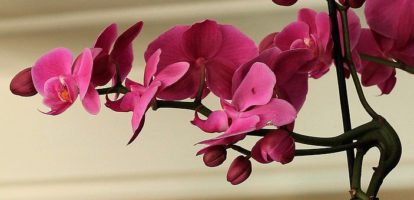
In this article, we shift our attention to the most beautiful flowering plants to grace your home. Some people will say that orchids are the most stunning houseplants to grow.
What follows are my recommended types of orchids to have in your home. As most orchids are grown for their flowers not much attention will be given to the plants, large green leaves, unless the leaves are the main focal point of the plant.
ANGULOA CLOWESII (Tulip /Cradle Orchid)
This orchid has tulip-shaped yellow flowers that are borne on short flower stalks. It originated from Colombia and despite its tropical origins, it can be successfully grown in cooler temperatures.
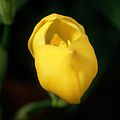
It is best to pot the plant in a specialised orchid compost, where in autumn the plant dies back. At this time the plant should be almost kept dry. It should be kept above 10 degree Celsius in slight to moderate shade, where the scent can be appreciated.
When the leaves appear once again, you can resume watering in spring. Watering is very important for orchids at lower temperatures, as too much can cause the plant to rot.
In the summer months, you need to feed and water often, which must start when the new leaves start to emerge.
BRASSIA VERRUCOSA (Spider Orchid)
This is a beautiful orchid that produces pale green scented flowers that have long, slender petals. The petals are also often darkly spotted. This is a good orchid for novices to have as it is generally easy to look after.

All you need to do is pot or repot in spring into an orchid compost, Temperatures need to be greater than 10 degree Celsius and it prefers to be grown in moderate shade, as long as it is given enough space to grow in.
You need to ensure that the compost is never too dry so that the pseudobulb shrivels up.
You need to water cautiously in winter and freely in summer, where the plant is in active growth. At that time the plants will need to be well fed.
A 13cm diameter pot is the ideal size to grow this orchid in.
CALANTHE VESTITA
This is another deciduous orchid, where spikes of numerous small white/pink blooms are observed. The flower spikes can be very tall and can reach up to 90cm in height.

What you need to do is plant one pseudobulb in a 13cm diameter pot using an orchid compost mixed well with chopped sphagnum moss. It is a quick-growing orchid and so may need to be potted on each year.
In late summer the leaves will start turning yellow, where you need to stop watering until next spring when growth starts once more.
Grow in a room where the temperature is not below 13 degree Celsius in moderate shade and humidity. The location must also be well-ventilated, especially in summer.
You will need to feed well when the plant is in active growth but at the same time, they do not like to be overfed.
CATTLEYA BOWRINGIENA
This orchid is easy to grow and the blooms look very impressive as well. This orchid produces stems containing 5-10 flowers combining hues of pink, purple and yellow.

The flowers of many cattleyas have five large petals that are pulled back from a central tube that is frilled at the end. The flowers are scented as well and therefore this orchid has a lot to offer the orchid lover.
It prefers to be grown in conditions of above 10 degree Celsius temperature and in good light but away from direct sunlight.
The plant requires to be watered moderately in summer, sparingly in winter. The pseudobulbs should never be allowed to dry out. After flowering start to reduce your watering rate until active growth is once more observed.
To plant use an orchid compost in pots that will retain their moisture. Normally a 13cm diameter pot will be sufficient.
The Cattleyas are one orchid that does well in hanging baskets.
CYMBIDIUM
This is a large group of orchids that make ideal houseplants for beginners. The flowers are the main talking point, as they often appear densely on spikes that are covered in flowers. The flowers themselves compromise fine petals and a central lip that complement the other petals well, the flowers come in a wide range of colours from yellow, pink, red, green and white.

The height varies from cultivar to cultivar but it can grow as high as 90cm or can be as small as 45cm. This orchid can tolerate cooler temperatures but it must be greater than 7 degree Celsius but this is especially true when the plant is flowering.
The plant prefers to be grown in light shade when flowers appear but from summer to autumn it needs to be exposed to bright sunlight to encourage the plant to flower.
Best to pot on using orchid compost. The pseudobulbs prefer being planted one-sided in an area of compost to allow room for its development
You need to water well in summer but much less in winter. An occasional feed in summer with half-strength liquid fertiliser will most certainly help the plant. This orchid has many hybrids so you are never short to what variety you can buy.
DENDROBIUM

The flowers of the Dendrobium are spectacular and come in many sizes. Some are large and produced in small number, whilst others are tiny and produced in larger number. These orchids need cooler temperatures than other orchids but also needs higher humidity.
An ideal position is to grow in temperatures above 10 degree Celsius in moderate humidity in shade from spring to summer, and in good light at other times.
It is best to pot or repot this orchid in a 13cm diameter pot full or orchid compost. You need to water sparingly in winter, enough to keep the pseudobulb from drying up. Generously at other times of the year.
D. infundibulum which produces 45cm tall hairy stems with large orange-lipped, white round flowers.

D. anosmum has long 1.2m tall stems or rose-pink or red-purple, spotted, large fragrant flowers. As it is a tall plant and so will need to be supported. This is a semi-deciduous orchid and some leaves yellowing is to be expected.
During the summer months apply liquid fertiliser every 2 weeks.
LAELIA ANCEPS
This is a medium-sized orchid that grows up to 60cm in height. In December and January stems that bear 2 to 5 large flowers are produced, which comes in many colours, with the pinks being the most noted.
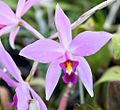
To grow this beauty you need to set the pseudobulbs one-sided as recommended for cymbidium. Do not pot on into a large container as this orchid appreciated being slightly root bound. Fill this container with an orchid compost.
This orchid needs temperatures greater than 10 degree Celsius in moderate humidity and a good light source, but away from direct sunlight. You need to water freely from April to November but hardly so in December to March, just enough to prevent the pseudobulbs from over-drying.
LYCASTE AROMATICA
This is another orchid that has deciduous leaves from which short stems of fragrant red-lipped, golden yellow flowers appear in early spring, This is one orchid that can be grown in a number of ways from using a 13cm pot full of orchid compost or it can be grown in slotted orchid baskets or even a tree branch that is covered in moss.

This orchid likes to be grown in a warm and humid place in the shade, the higher the temperature the better. When the leaves are emerging you need to water freely, but once the leaves start to fade, you need to give the plant some rest. Add just enough water so that the plant does not die, especially in the winter months to ensure the pseudobulb does not shrivel.
MILTONIOPSIS (Pansy Orchid)
The shape of the flower gives its common name. You may find it sold under its old name of Miltonia. This orchid bears flowers stems which one solitary purplish flower appear in summer, but they can be yellow, red, or brown, Some cultivars instead can produce 5 flowers per stem, so you do have a choice.
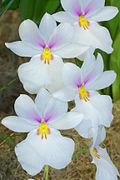
This plant is best grown in slated orchid baskets or they can be grown in 13cm diameter pots that have good drainage. Every 3 or 4 years it will need to be repotted into a larger container.
Grow it in a cool well-ventilated position of moderate humidity and light shade in summer. At other times of the year, you need to place the plant in good light. For an orchid, it is not a tall plant.
This is one orchid that needs to be watered all year round, as the compost needs to be moist at all times. Water more freely in summer.
ODONTOGLOSSUM (Tiger Orchid)

This genus contains some of the most dramatic flowers of all the indoor orchids. The flowers are produced over a wide time frame, as you can have flowers in spring, autumn and winter. This does not mean you will have flowers over 9 months of the year but with different species then this is possible. Not a tall plant but can grow up to 50cm in height.
It requires a minimum temperature of 10 degrees Celsius in order to do well in moderate humidity but will do well in average to cool temperature all year round. The plants need to be grown in bright indirect sunlight. Bright in winter but less so in summer.
The plant needs to be kept moist at all times, slightly less so in winter. In summer you can water freely.
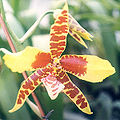
Varieties to grow include:
O. bictoniense that has oval flattish pseudobulbs that has long stems bearing numerous butterfly-like flowers. The flowers are either pink, red or yellow.
The more famous variety to grow is O. grande that produces flower spikes with 4 to 7, 18cm in diameter blooms that have red, brown and yellow spots, stripes and bands. This is one orchid that can be grown on the windowsill. It flowers in autumn and regrows in spring. Keep water off the leaves as it will become marked and spoilt. This is a short and smart-looking orchid.
ONCIDIUM
This is one orchid that produces masses of small, yellow and red flowers in autumn and winter. The flowers are often borne on arching stems that droop gracefully below the main body of the plant. These arching stems make them ideal for use in hanging baskets filled with a mixture of moss and orchid compost.

The plant can be grown in 13cm diameter pot or orchid compost, where you can plant the pseudobulbs one-sided as previously mentioned with cymbidium.
This plant develops very quickly and so mature plants will need to be propagated every 2 to 3 years.
Grow in average to cool temperatures all year round in moderate humidity and in light during autumn, winter and spring. In summer shade from the midday sun.
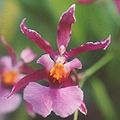
During summer you will need to water freely, whilst in winter you just need to water to keep the leaves from wilting.
The varieties to look out for include O. ornithorhynchum that has long stems bearing pink flowers in October to December.
O. flexuosum has more distinct flowers of all the species you can grow, as it has large yellow, scallop-lip. You need to mist regularly to keep humidity.
PAPHIOPEDILUM (Slipper Orchid)
The common name arises because of the unusual shape of the lower petals that are fused into a pouch, which resembles a slipper.
The flowers also have enlarged upper petals with two wing-like petals. This is usually borne individually on each stem that is darker than most other orchid stems. This really shows the flower beauty the most.

The plants prefer to be grown in moderate warm conditions in high humidity and in bright filtered light. It dislikes any draught and cold temperature in direct sunlight.
P. insigne, on the other hand, needs to be grown in cooler temperatures in moderate shade with good ventilation. It can be grown as a small plant or be allowed to clump together, depending on your space availability.
Grow this orchid in 10cm pots full of orchid compost and repot every 2 years. With P. insigne, which is a larger specimen you will need to use larger pots and allow the plant to mature without any disturbance. An easy plant to look after.

You need to keep the compost moist all year round but avoid wetting the leaves, as this will lead to leaves marking. In cool temperature reduce your rate of watering. Feed with a quarter strength orchid feed every couple of weeks.
P. callosum has attractive evergreen nettle-like leaves and blooms with white, green and purple striped slipper-like flowers from January to June.
Whilst P. insigne has yellow-green leaves with yellow-green, brown spotted and striped flowers. These orchids do not grow to very great heights, only reaching 35cm.
PHALAENOPSIS (Moth Orchid)
This is the most graceful and elegant of all indoor orchids. It produces one flowering spike that is dotted with flowers, which when open has a round shape look like a moth. The flowers are often scented and that adds to its charm.

This is one orchid that requires warm temperatures to do well in order to produce blooms. You need to place it in a room that has plenty of warmth and in bright, filtered light.
You need to water freely whilst the plant is actively growing but in winter just water enough to keep the compost from getting too dry. Every month feed with a quarter strength orchid liquid fertilizer. Humidity needs to be high at all times and to achieve this you need to mist the plants once a day. A beautiful orchid to have around your home.
CONCLUSIONS
In this second part of the series, the best orchids to have in your home has been discussed. As you can see there are a large number of orchids that can grace your home with their beautiful, colourful, exotic-looking flowers. You can now see why a lot of orchid growers pick up the growing bug.
In this series, you can see that a lot of growing myths have been dispelled. They do not have to be expensive, they do not need a lot of time or cost to look after, and that some of them are scented.
The orchids I recommend certainly will not bust the bank, and so if you want a plant that looks elegant and graceful in your home then you cannot go wrong with an orchid. The houseplant which makes other houseplants look ordinary.
If you have a comment or question about orchids that have been bugging you, please do so in the comment box below.
Thanks.
Happy Orchid Growing.

Orchids are very beautiful plants and has lovely smell too, I have some in my office, they beautify the place and it’s pleasing to the eye.
Learning of several orchids to choose from or grow in the home is quite fascinating, I do not know a lot about these flowers so I’d like to see the first part of this topic to learn how to get the growing conditions right.
Id like to learn about it and start growing them in my home, maybe add some other flowers to spice things up a notch.
Hi Samikingss
Thank you for stopping by and commenting as it is really much appreciated. Orchids are plants that are beautiful to the eye and as well as to the nose. You have plenty of choices and hence why this article was written.
Kind Regards
Antonio
You provided details about 13 to 14 orchids of an amazing diversity. The orchid I am most familiar with is the cymbidium orchid that is commonly sold in grocery stores. All the others are new to me. Your comment at the end that all orchids make the other houseplants look ordinary was an eyeopener.
When I attending boarding school in the Himalayan foothills we used to discover orchids growing as grafts on the bark of the pine trees in the wild. They looked surreal and beautiful.
Orchid flowers also seem to last longer. They look very elegant and add almost an oriental flair to any setting. After reading your article I shall be looking out for other kinds of orchids to grow as houseplants.
Edwin
Hi Edwin
Thank you for this. I am always interested in what people bring to the table and their own past experiences. Orchids are some of the most beautiful houseplants you can have and the choice is difficult. I wanted to help people choose and hence why this article was written.
Kind Regards.
Antonio
Thank you so much for this wonderful article
I’ve been trying to grow orchids as a home plant for a long time. but I don’t have an idea about it. but after reading your article I had some ideas about it. I decided that I will cultivate CYMBIDIUM flowers. Because personally I like this flower very much. it’s my favorite flower. To me, this flower seems very easy to cultivate. Thanks, your article help me a lot. you really wrote an informative article about Growing Orchids as Houseplants and described very well. this article also helps those people who want to cultivate flowers in their houses.
Hi MD
I am glad to be of service and hope you buy an orchid or two.
Thanks
Antonio
Hello Antonio,
I myself have the miltoniopsis (Pansy Orchid), I received it as a gift last month and I just found out that it needs to be repotted every 3 or 4 years and to be in a cool well-ventilated position of moderate humidity. Good to know how to take care of this gift I got. It’s just like a puppy, I came to grow in love with it, giving my house a good look and vibe. Thanks for this valuable content I’ll be treating my orchid more better
Hi Michael
When you are bitten by the gardening bug, your plants become like your children and you will do anything to see them flourish and grow. You worry when they look unwell and you are happy when they show their brilliance. This is why growing guides and plant lists are very useful.
Enjoy your plant.
Antonio
I signed up for your freebie because I love house plants. I have a number throughout the house and a number of orchids under my deck which my husband has made into a fernery, but the orchids seem to like it too. My other favourite plants to have in the house are succulents and cacti, which are just so easy to grow. What fertilisers do you recommend to get the most amount of flower spikes out of cymbidiums.
Hi Deb
Thank you for the signup and I could not agree more that Orchids are some of the most beautiful houseplants you can buy. In terms of orchid fertilisation, it is better to use a general liquid fertilizer for orchids, as it has been specifically designed for use with orchids. This is why I also recommend when potting on to use orchid compost as it will take the hassle out.
I have written an article on cacti and succlent houseplant, which will be published in the near future. It is very useful for those who are unsure about which specimens to buy.
Kind Regards
Antonio
Hi Antonio and thanks for this well written piece. I’ve literally been schooled on orchids by your article and and never envisaged them as houseplants. I like the caution of now watering out of habit as is the case on many to-do lists, because we could easily kill the plants out of ignorance!
You do mention they “do not have to be expensive”. Any pointer on the estimated price? Thanks.
We are Blessed.
Hi Mark
Thank you for this inciteful and helpful comment. it is always good to check, as although you can give overall guidance, they need to be tailored to each plant individually, otherwise, they will not be at their best. Watering is very important for the plant to do well, not too much, not too little. Price range is around £5 for a supermarket specimen to £10.000 + for more exotic varieties.
Kind Regards
Antonio
Hello, I really want to first appreciate your effort in putting this great website together and writing this useful article. all this while, Now we planning to have all recommended types of orchids at our home. Your step by step guide is very helpful to setup all. As we can see there are a large number of orchids that can grace your home with their beautiful, colourful, exotic-looking flowers.
Hi Parveen
Thank you for the glowing comment, as it is very much appreciated. Orchids are beautiful houseplants that you wonder why they are not in everybody’s home, where the beautiful flowers can be enjoyed.
Kind Regards
Antonio